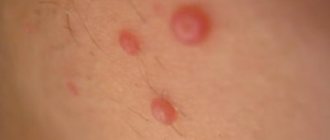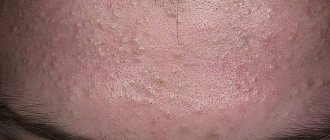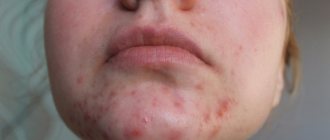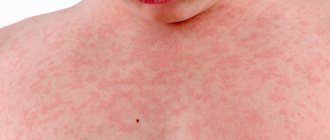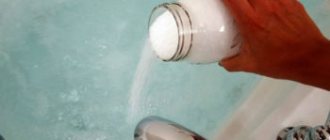How to protect your skin from acne and burns with blisters during the swimming season at sea? You should look for answers to this question even before your first trip to the beach. Blisters and burns leave behind dark spots for the rest of your life, and acne doesn't add beauty to your skin either. In order not to ruin your vacation, those who like to spend it in hot countries by the sea should adhere to some rules.
What are sun acne?
Pimples that appear after exposure to ultraviolet radiation on the skin are small rashes. Typically, the area where the rash appears becomes red and itchy.
On this topic
- Pimples
13 ways to prevent acne
- Inna Viktorovna Zhikhoreva
- March 29, 2020
In most cases, ultraviolet radiation has a beneficial effect on the skin, since under its influence it destroys pathogenic bacteria that are located in the tubercles and dries the skin.
Sometimes sun rays, on the contrary, provoke the appearance of acne, since there is a negative effect on the epidermis, namely:
- the sebaceous accelerates ;
- the skin becomes dry, resulting in clogged pores;
- natural defenses deteriorate.
In any situation where small pimples begin to appear after sunbathing, it is better to consult a dermatologist.
Acne appeared after sunbathing, what to do: folk remedies
Folk remedies have been used for many years, they have been tested for years, and many of them are more effective than medications. They will save you from acne after sunbathing and also prevent their development.
Chamomile and calendula
To prepare the medicine, you need to pour half a liter of boiling water over a spoonful of flowers. Let it sit for half an hour and strain. Wipe the affected areas with a cotton swab soaked in the medicine.
Aloe tincture
Making aloe tincture is quite simple. Cut off a few leaves of a young plant and place it in the cellar or refrigerator for 10 days. Grind the leaves to form a porridge, pour boiling water in a ratio of 1:5. Leave for one hour, put on the fire, bring to a boil and remove from the stove. Strain the cooled medicine. If the pimples that appeared after sunbathing are not inflamed, wipe them with pure juice.
Fir oil
If your skin is combination, you can wipe acne from sunburn with fir oil. It has bactericidal properties and does not dry out the skin. Dampen a cotton swab or gauze and gently wipe the affected areas.
People's advice:
• To avoid the formation of acne spots, lubricate the acne area with hydrogen peroxide.
• Before you go sunbathing, eat a few slices of lemon, it prevents the formation of acne. If you can’t eat it in its pure form, drink tea, but add lemon to it.
• Include ginger in your diet, it cleanses the skin of impurities and toxins.
• Wipe your skin with carrot juice or juice obtained from fresh parsley.
• During the summer, eat more fruits and vegetables.
• When you wake up in the morning, wipe your face with milk.
• In the evening, apply cucumber slices to your skin, then wash with cool water. As you know, cucumber is a good remedy to relieve irritation.
The condition of our skin can be used to judge the state of the body. If you are constantly attacked by acne when you are in the sun, reconsider your lifestyle; perhaps you are tanning incorrectly.
Pharmacies have a large selection of products to protect against tanning and prevent acne.
Tan correctly, and then your skin will be healthy and beautiful!
Causes
Various factors can contribute to the appearance of acne or rashes on the skin after exposure to sunlight. It is worth noting that the basis of any such pathological condition is an inflammatory reaction, the elimination of which will depend on the etiology of origin.
There are several main reasons that can trigger skin rashes:
- Photodermatitis. This is a rare disease that can occur due to intolerance to ultraviolet exposure. If acne appears in a short time, and it itches a lot, then we can talk about this disease.
- Staying in the sun for a long time without using special sunscreens. As a result of the penetration of ultraviolet light deep into the layers of the skin, an increase in the temperature of the fluid located in the cells is observed, under the influence of which the production of histamine, a substance that mediates inflammation, occurs. There is redness and pain on the skin. Blisters begin to appear. This reaction can also be provoked by products that have a low level of sun protection.
- Malfunctions of the sebaceous glands. As a result of frequent and prolonged exposure to the sun, the skin becomes dry. Against this background, the glands begin to actively produce sebum, which leads to clogging of the ducts. Over time, dust and dirt get into the secretion. All this becomes an excellent habitat and breeding ground for pathogenic bacteria, which provoke the development of an inflammatory reaction. A pimple forms at the site of the lesion, often with pus.
- Allergic reaction to sunscreen cosmetics. If the drug is chosen incorrectly, the quality of the product is poor, or it is used after the expiration date, unpleasant consequences may begin to develop on the surface of the skin. In most cases, the provocateurs of this condition are flavoring additives: essential oil of cedar, bergamot, lemon.
- Excessive sweating. This is a specific feature that manifests itself with increased exposure to sunlight on the body. In this situation, the formation of a rash is a sign of skin irritation. In addition, particles of dirt and dust accumulated on wet skin can also cause inflammation. This happens especially often when the body’s immune system is weakened.
- Treatment with certain medications . Certain groups of medications lead to a temporary increase in skin sensitivity to ultraviolet radiation, as a result of which the surface of the epidermis becomes covered with acne.
It is important to remember that before going outside in hot weather, you must use only high-quality protective equipment and do not forget to regularly carry out hygienic procedures to cleanse your skin.
Protective factor: which one to choose?
This is the name given to the degree of gradual increase in time spent under ultraviolet rays before a reaction appears - hyperemia or red skin. An index of 15 SPF on a protective product will mean that after applying it you can be exposed to the rays 15 times longer than without the protective product.
If you buy an American product that says “made in USA”, then it is important to know that American manufacturers take other standards for the protective factor that are 1/3 higher than those adopted by Europeans. In practice, we have been convinced that milk of American origin with a protective factor of 15 corresponds to a product from Europe with a protection factor of 10.
Tanning oils only partially protect the skin. They are more suitable for low-problem epidermis that quickly tans. Tropical oils do not have sunscreen filters, so the beautiful packaging may hide ordinary oil, which in bright sunshine should not be used at all by children and white-skinned people.
Jelly, which also does not contain fatty or emulsifying additives, can protect against “Mallora” acne in the form of small, itchy redness with pustules. Along with tanning jelly, you should use preparations that do not contain emulsifiers or fatty additives.
Sand and sea water increase the impact of ultraviolet rays. Therefore, unpleasant consequences and acne breakouts can occur even in cloudy weather. When choosing a sunscreen, pay attention to the SPF level, take into account your skin type and the expected time of exposure to the sun.
Risk factors
There are certain categories of people who are more susceptible to rashes on the body after sunbathing. The risk group includes:
- people with light tone or fair hair;
- women during pregnancy ;
- people who abuse trips to the solarium;
- girls after chemical peeling or permanent makeup;
- children in infancy ;
- people belonging to a certain age category.
In addition, the cause of acne can be increased metabolism, lack of vitamins, diseases of the gastrointestinal tract, as well as weakened immunity.
Is tanning really beneficial?
The majority of white-skinned people in northern countries believe that with the help of a long-lasting chocolate tan they can improve their health and become beautiful and attractive. Southerners, for whom relaxing on the beach is not exotic, have been familiar with the sun since childhood and treat it with objective caution. And irresponsible travelers are forced to be disappointed when, the next day after the first sunbathing and swimming in warm water, acne or photodermatitis appears on the face and body.
Tanning is necessary for the epidermis in summer as protection from exposure to direct ultraviolet rays. Excess tanning causes the skin to fade, dry out, and become hypersensitive. The price you pay for having a bronze color is dryness, wrinkles, acne, and putting you at risk for skin diseases, including cancer.
Symptoms
The following signs may indicate the development of solar urticaria:
- redness ;
- itching;
- numerous rashes;
- soreness of the affected area;
- bleeding of crusts due to severe burning of the skin.
In most cases, prolonged exposure to direct sunlight can provoke pathology. Sometimes eczema may begin to develop. At an advanced stage, the rash appears even in areas that have not been exposed to the sun.
When to see a doctor
The appearance of acne from the sun on different parts of the body depends on the characteristics of the body. For some girls, acne from the sun appears more often on the face; areas of the nasolabial triangle and forehead are especially susceptible to breakouts. Others often experience acne on the back and décolleté. Many people regard the appearance of inflammatory tubercles without any particular concerns. But in fact, there are some signs when your skin needs immediate treatment.
The fact that you need to visit a dermatologist may symbolize a sudden rash on a certain area of the body with an unpleasant itching sensation. You should also be wary if the pimples that appear begin to itch.
If you have a sunburn over a large area of skin, you should also consult a dermatologist to avoid cracking of the burn crust and infection.
The appearance of ulcers and watery blisters is considered a bad sign; in some cases, they can develop into eczema or blisters, which, if infected, can cause blood poisoning.
Important! You should immediately consult a doctor if a sharp increase in the affected area is noticed. Especially if inflammatory rashes began to appear in places that were not exposed to solar radiation.
Types of reaction
Dermatologists identify several types of negative reactions to sun exposure. These include:
- Phototraumatic. This group also includes burns that were received as a result of tanning. This type of reaction occurs when a person is exposed to sunlight for a long time.
- Photoallergic. It occurs as a result of a malfunction of the immune system, with an acute reaction of the body to exposure to ultraviolet radiation. This reaction is easily recognized by the appearance of various types of rashes, for example, vesicles, papules or oozing. In rare cases, lichenification of the skin may occur.
- Phototoxic. The cause of the appearance may be the use of medications, plants or foods that can provoke a photosensitizing effect.
What kind of reaction occurred in a particular case can only be determined by a dermatologist.
Watery rash after sunbathing
A watery rash after sunbathing is most often a sunburn. The elements of the rash are vesicles and blisters of various sizes filled with a cloudy liquid. Such rashes appear on the most exposed areas of the skin. Individual blisters may coalesce to form a large, watery blister. Subsequently, the bubbles open on their own. The top layer of skin on the affected areas usually comes off completely. Sunburn is accompanied by severe pain and discomfort, as well as fever, weakness, malaise and headache.
Treatment
The choice of treatment method will directly depend on the cause that provoked this pathological condition. In order to determine what could cause such a reaction, you need to consult a dermatologist. After conducting an examination and studying the test results, he will be able to give recommendations on the choice of means that will help eliminate the problem.
In the treatment of photodermatitis, only complex therapy will help. In most cases, the specialist prescribes antihistamines.
For external use, products containing panthenol are most often used. It is also recommended to make chilled lotions based on a decoction of medicinal plants. Typically, such procedures are sufficient to eliminate the symptoms of the disease.
On this topic
- Pimples
5 ways to get rid of acne right now
- Inna Viktorovna Zhikhoreva
- March 29, 2020
In more advanced cases with a severe course of the disease, the doctor prescribes treatment with antibiotics and hormonal drugs.
After completing a course of such therapy, patients are further contraindicated from exposure to the sun. If necessary, you can go out into direct sunlight only when your body is completely covered with clothing made from natural fabrics. It is mandatory to wear a hat on your head. This is the only way to protect the skin as much as possible from the recurrence of the rash.
To eliminate burns that a person has received as a result of being in the sun for a long time without using a protective product, you will need to be patient. To relieve pain and fever, non-steroidal anti-inflammatory drugs are usually prescribed.
For local treatment of the skin, creams and ointments with panthenol are used. In order not to bring the skin to this state in the future, it is recommended to select a cosmetic product more carefully.
On this topic
- Pimples
How to quickly get rid of acne on the chin
- Inna Viktorovna Zhikhoreva
- September 27, 2020
If an allergic reaction occurs, caused by the use of a sunscreen, it is recommended to take a course of any antihistamine, as well as change cosmetics.
If you experience excessive sweating, you also need to undergo additional examination by a specialist to rule out more serious diseases. Only a doctor, based on the results obtained, will advise which treatment will be most effective in this case.
How to cure acne after sunbathing?
Considering that the causes of the rash are different, it is best to consult a cosmetologist or dermatologist to exclude the development of more serious complications.
There are several ways to treat acne caused by the sun:
- If a rash appears after using protective products, then simply stop using them. If everything goes away, then such cosmetics are simply not suitable;
- When the cause is photodermatitis, it is important to protect the skin from the sun for some time, using various products and closed clothing. Treat damaged areas on the chest, shoulders, face and other parts of the body with Diphenhydramine solution. It is recommended to consult a doctor, since in case of complications, a course of special medications is important;
- If after a trip to the sea you develop rashes after sunbathing, then this may be due to dehydration of the skin, so ensure hydration. Please note that even oily skin needs nutrition and hydration. Give preference to creams with a light texture, as they do not expand or clog pores. It is equally important to use cleansers that do not contain alcohol. Another important point is to maintain hydration by drinking enough water;
- If the desire to get a beautiful tan has led to a burn, then use Panthenol or Lioxazine in the form of a gel topically. To relieve itching, it is allowed to take antihistamines;
- You can treat rashes after sunbathing using cocoa butter, which is used to wipe the affected areas.
To prevent tanning from causing rashes and other skin problems, it is recommended to use masks. Such folk remedies help restore the barrier function of the skin, regenerate cells, and improve the production of collagen and elastane. First, you should test the mask on any area of tanned skin. They need to be done 2-3 hours after sunbathing. The procedure cannot be performed more than 2 times every 7 days.
Effective after-sun masks:
- Cottage cheese. Take 2 teaspoons of full-fat cottage cheese and add 1 teaspoon each of fish oil, strong tea and lemon pulp;
- Cucumber. Grind the cucumber on a fine grater and mix with kefir in different proportions;
- Lemon. Peel the cucumber, grate the pulp and add 10 drops of lemon juice.
Prevention
To prevent the appearance of acne on the skin after exposure to ultraviolet radiation, it is recommended to adhere to certain rules:
- Before sunbathing, the surface of the skin must be treated with special cosmetics.
- For tanning, it is better to choose the morning hours, before eleven in the afternoon, and also the evening time - after five. On average, ideally you can stay in the sun for no more than twenty minutes.
- Before going out, it is advisable not to apply foundation or makeup base to your skin, and also not to splash yourself with eau de toilette. In addition, it is better not to use decorative cosmetics on the face at all in the summer.
- sunscreen to your skin about half an hour before going outside .
- After bathing, it is also better not to dry your body.
- If you are prone to an allergic reaction, you can take anti-allergy medications after consulting with a specialist.
Constant skin care is equally important. Particular attention to hygiene procedures must be taken in the summer on hot days.
When washing, it is recommended to use not just water, but also antibacterial agents. Tar soap has a good effect. It most effectively cleanses the skin of impurities and has an anti-disinfecting effect.
It is also strongly recommended not to touch your face with dirty hands. If you sweat profusely, it is better to use wet sanitary napkins. Even after washing, bacteria can remain on your hands. Sweat is an ideal environment for both habitat and reproduction. It is pathogenic microorganisms that are primarily capable of causing skin rashes.
It may only take a few days for your pimples to clear up. The main thing to remember is to never try to crush them, open them or touch them with unwashed hands. If you do not follow these simple rules, you can significantly worsen the situation, which will lead to more serious consequences.
A little about sea water and salt
Sea water and salt have a beneficial effect on human skin and treat diseases of the respiratory system, musculoskeletal and nervous systems, and gastrointestinal tract. Sea water has a beneficial effect on skin diseases; it heals scratches and deep wounds. Sea water is 92-95% identical in composition to blood plasma, and salt contains many useful elements and is more suitable for us than ordinary table salt. Sea salt is used to treat many diseases; it is added to medicinal baths. Salt water is suitable for compresses, hand and foot baths, it is used to make lotions, applications, inhalations and is included in natural cosmetics, both on an industrial scale and at home.
After swimming in the sea or estuary, the salt dries and remains on the skin. It turns into a million magnifying crystals that attract ultraviolet rays. Therefore, after such water procedures, a shower with fresh water is simply necessary. If there are a large crowd of people on the beach and stray dogs are running around, then people with sensitive skin can get acne from contaminated sand and sea water. If there are many ships in the roadstead, then they also pollute the water, since they wash away all the “excess ballast” into the sea. Most of the dirty water from washing ships soon reaches the shore.
You can quickly remove or prevent acne by rubbing it with the following: add vodka to water in a ratio of 2:1, 20 drops of iodine and 2-3 tbsp. l. sea salt, provided that there are no burns on the skin. It turned out to be an excellent disinfecting body scrub. All that remains is to scrub the skin with a scrub using a hard brush on a natural basis. We do not wash off the product, but wipe the body with a soft towel. You can wash yourself with warm fresh water from the shower only in the morning after swimming in the sea.
Sea water contains a lot of debris and microorganisms that adversely affect the quality of the skin. And ultraviolet rays with prolonged exposure reduce the immunity of the skin, which loses its ability to withstand the negative influence of external factors. These conditions lead to the formation of acne and other dermatological problems.
Prevention of rashes on the body after sunbathing
If you want to have a good rest and get a beautiful tanned body without acne and blemishes, follow simple rules. First, remember that you can sunbathe only during those hours during which the sun's action is least dangerous. Despite the fact that after 15.00 hours the activity of the sun's rays begins to decrease, even at this time there remains a danger of getting sunburn. To obtain a proper and safe tan, dermatologists recommend sunbathing before noon (from 7.00 to 11.00). Otherwise, you risk burning and damaging your skin. The most ideal time for sunbathing is 10.00 am. During this period, the sun's rays do not burn, but warm. Secondly, when you come to the beach, do not rush to immediately lie down on a sun lounger. Walk around a bit, give your body a chance to relax and your skin to get used to the warmth of the sun.
Do not overdo it on the very first day of rest. Limit your tanning time to 15 minutes. This is exactly how long it takes for the skin to adapt to the effects of ultraviolet rays. When sunbathing, try to lie with your feet towards the sun to ensure an even tan. Increase your tanning time every day and do not forget to use special lotions, tonics and creams that are most suitable for your skin type. Remember that high-quality tanning cosmetics are needed not only to enhance the tanning effect and give the skin a seductive dark shade. The beneficial components of such products protect the epidermis from burns and dehydration, and also make the skin soft and elastic.
You will also find our articles useful: How to get a good tan? How to sunbathe in a solarium?
Pharmacy drugs
What medications should be used for acne that appears after the sun? These are mainly antiallergic drugs and drugs containing panthenol. The most popular drugs that eliminate rashes and skin itching are:
- Panthenol;
- Fenistil;
- Dexpanthenol;
- Radevit.
It should be remembered that medications that contain hormones, corticosteroids and antibiotics should be used only in extreme cases. However, if the skin is severely damaged, your doctor may advise:
- Fluorocort;
- Advantan;
- Hydrocortisone.
They should be taken with extreme caution, as an overdose can lead to disastrous consequences.
Remedies such as:
- Solcoseryl;
- Karatolin;
- Psilo-balm.
In order for the irritating substance to leave the body faster, you can take enterosorbents. The most commonly prescribed are Filtrum, Enterosgel and Polysorb. They must be washed down with water.
If a person is allergic to the sun, he should take antihistamines, for example, Suprastin, Cetrin or Zodak. Allergic reactions after using these drugs will be blocked.
If photosensitivity is a consequence of vitamin deficiency, you need to take the necessary vitamins. Vitamins of group C, B, E are especially useful.
Usually, a few days are enough to eliminate acne from the sun. The main thing is not to open or squeeze them out. If your skin condition does not improve, you should consult a doctor.
anonymously
Hello, my name is Vera, I'm 27 years old. I've been getting red spots from sunburn for 10 years now. It started at the age of 16 - I first went on vacation at the seaside for 2 months to visit relatives in Ukrvina in Berdyansk, all this time I was intensely sunbathing, from 10 in the morning until the evening, until it got dark, I lay on the beach. Everything was fine, a beautiful dark tan, which I never had, since my skin and hair are light and I live in Siberia. In fact, my skin started to itch. After 2 years, I went to Berdyansk again, sunbathed for a week and red spots appeared on my arms, small, about a centimeter in diameter, then they appeared on my face, chest, stomach, and last but not least on my legs, then small ones appeared bubbles that inflated every time it was hot, even for example in a bathhouse, or on the street under clothes. There was no itching, but it was still unpleasant. When I arrived home, the red spots had passed and turned into white, untanned ones. This happens every time I go somewhere to the sea to relax, come to my hometown, go to the dermatologist, and they tell me that everything has already passed and they cannot prescribe treatment for me. When these spots appear again, then come. I’m planning to go to Turkey at the end of July, tell me what kind of spots these could be and how to protect myself from them?
Hello! Most likely, you are worried about photodermatitis. This condition is associated with the appearance of elements on the skin under the influence of solar radiation. The easiest way to prevent the elements from appearing is to protect yourself from the sun, not only with mechanical protection (brimmed hats, clothing, etc.), but also with photoprotection. The photo filter (SPF factor) for you should be at least 50. If itching occurs, you can take antihistamines. It must be remembered that some substances increase the sensitivity of the skin to ultraviolet radiation, for example, oral contraceptives, products containing tar, some antibiotics, so you should refrain from exposure to the sun when using them. Sincerely. A.S. Beltyukova
Consultation with a dermatologist on the topic “Sun Allergy” is provided for informational purposes only. Based on the results of the consultation received, please consult a doctor, including to identify possible contraindications.
About the consultant
Details
Graduated from St. Petersburg Medical University named after Acad. I.P. Pavlova. She continued her studies in internship and full-time graduate school. In 2009, she successfully defended her PhD thesis in the specialties “skin and venereal diseases” and “allergology and immunology”. She specialized in cosmetology at the St. Petersburg Medical Academy of Postgraduate Education. Certified specialist in the following areas: laser medicine, biorevitalization, mesotherapy, botulinum therapy (use of Botox, Lantox, etc.), treatment of hyperhidrosis, hardware cosmetology. Successfully corrects age-related changes in the face, shape and volume of lips using hyaluronic acid preparations (Juvederm, Restylane, Belotero and CRM).
Good afternoon Please tell me - after tanning in the sun, red spots appear on my body, at first they are small in diameter, but then they begin to enlarge and itch terribly... In the end, I still have sores and if I get exposed to the sun again, they swell a little and again They itch unbearably... I had consultations with 3 dermatologists - they couldn’t tell me anything intelligible. Because of this problem, I can’t even leave the house during the day. This whole thing goes away at the end of summer and I’ve been suffering for 4 seasons now... Please tell me how this can be cured?
Inna, Saratov, Russia, 27 years old
